
リーダーとして精神的に成熟するためには何が必要か?
前回の記事では、リーダーの成長の鍵は技術課題ではなく、適応課題であり、価値観の変容を伴う精神的成熟が大切となるということをお話しました。
今回の記事では、精神的に成熟するためにはどうすればいいのかについてお話したいと思います。
精神的成熟には、矛盾に葛藤する経験が必要
リーダーの成長の多くは「経験」から生まれると言われます。リーダーシップ研究の調査機関である米国ロミンガー社は、リーダーの成長の70%は経験、20%は他者からの薫陶、10%はトレーニングと言っています。他者からの薫陶やトレーニングなどの要素もあるものの、経験がリーダーを育てるということについてはみなさんも実感値に合うのではないでしょうか。
それでは、何らかの経験を積んでいればリーダーは成長するのか?と言えば、必ずしもそうではないことがわかります。皆さんの身の回りでも、経験を積むことで成長していくリーダーもいれば、経験は積んでいるけどあまり成長できていないリーダーも思い浮かぶのではないでしょうか。
前回の記事で、精神的成熟とは矛盾の両立に向けた「段階的な変容」であると述べました。本来の自分と周囲との調和をする中で、生じる矛盾に対して向き合い、その矛盾を統合していく過程において価値観レベルの変容が起こります。
ですから、精神的成熟につながる経験とは、「矛盾に葛藤する経験」である必要があります。本質的にはどのような矛盾かといえば、「主体的真理に生きることと、周囲と調和して生きることの矛盾」であると言えます。
平たく言えば、「自分のありたい姿と現実の矛盾」「自分のありたい姿と、周囲のありたい姿の矛盾」「自分のありたい姿と会社から期待されるあるべき姿の矛盾」ということになります。
このような「矛盾に葛藤する経験」は、それを克服することができると、精神的成熟=器の広がりや人間力の高まり、を伴いますので、「一皮むける経験」と表現されることもあります。
リーダーとしての成長(の根幹)
=
精神的成熟を伴う成長
=
器の広がりや人間力の高まり
=
価値観レベルの変化を伴う成長
=
技術課題ではなく、適応課題への対応を伴う成長
リーダーとしての成長を促すために必要なこと(の主要なもの)
=
一皮むける経験
=
矛盾と葛藤する経験
=
「主体的真理に生きることと、周囲と調和して生きることの矛盾」
に向き合う経験
矛盾との葛藤を乗り越える共通のストーリー
私自身、起業をしてから、矛盾と葛藤する経験を乗り越えながら今に至ります。その中でも大きかったものとしては、「多額の個人保証を抱えながら、最後は自分でやるしかないと一人で背負いこんで生きようとする自分」と、「周囲と調和しながら、一人一人の思いを紡いで、チームとして価値創造したいと思う自分」との矛盾でした。
(その矛盾と葛藤するストーリーについては、こちらの記事で詳しく話しをしていますので、そちらもご覧ください)
矛盾との葛藤に向き合っていく中で、その時々の矛盾の内容が違っていても、それぞれの矛盾との葛藤を乗り越えるストーリーには共通のものがあるなと思い始めてきました。
そのときに出会ったのが、ジョセフ・キャンベルの「英雄の旅」と、禅の「十牛図」です。
「英雄の旅」は、神話学者ジョセフ・キャンベルが、世界各地の神話を研究する中で、神話には共通するパターンがあることを発見したものです。そのパターンとは、大まかに言えば、冴えない現実にいる主人公が、未知との遭遇の旅にでかけて、メンターや仲間からの支援を得ながら、幾多の試練を乗り越えて新しい力を獲得していき、旅の終盤で最大の試練を克服することで栄誉と栄光を手に入れ、元の場所に新しい自分として還ってくるというものです。
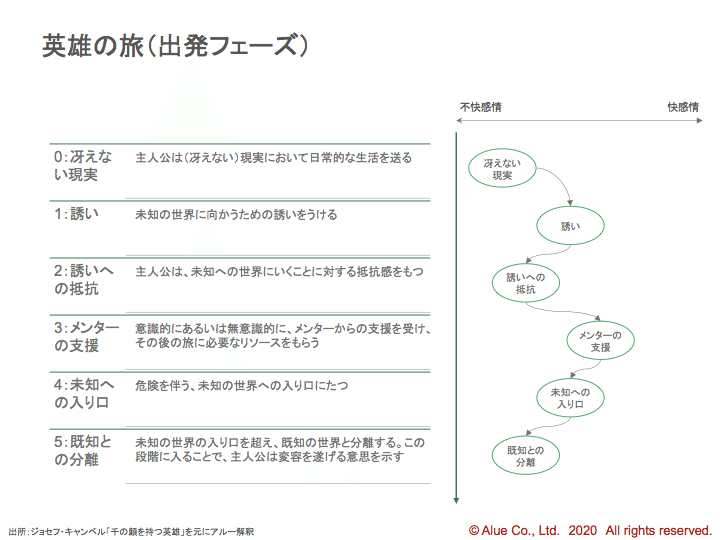
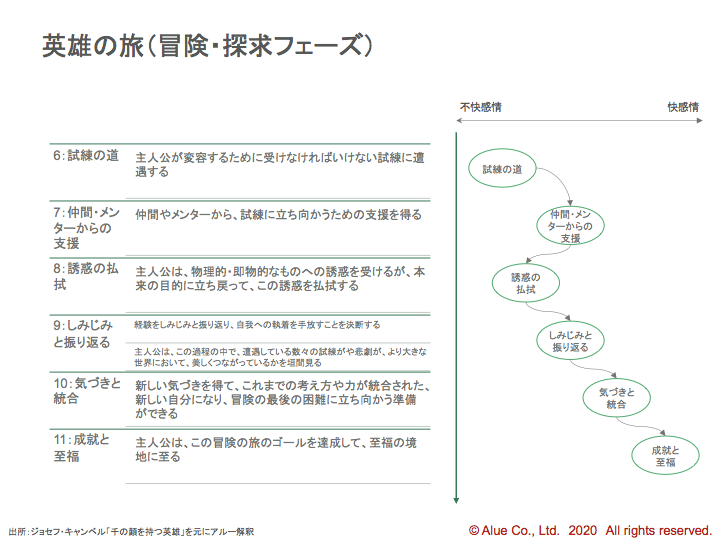

この「英雄の旅」は、神話において共通しているストーリーの原型というだけではなく、ヒットした映画のストーリーの原型としても活用されていると言われています。例えば、ジョージ・ルーカスが、スターウォーズのストーリーを考える際に、英雄の旅を一部参考にしたというエピソードがあります。
もう1つの「十牛図」は、中国の栄の時代における禅の入門書です。一匹の牛が登場しますが、普段はおとなしいけれども暴れ出すと凄い力をもつ牛を、人の心に喩えています。牛を見つけて、牛を飼い慣らして、牛と一体化していくプロセスを記述することで、悟りに近づく道を示したものです。
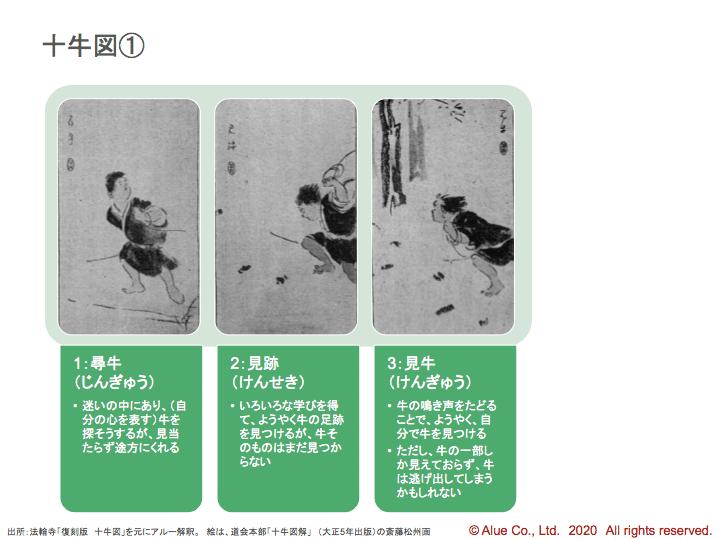


どちらにも共通しているのは、「(本質的には)人の内面の葛藤を描いており、その葛藤を克服するプロセスを記述している」ということです。
「英雄の旅」においては、試練の場面にでてくるものは、主人公とは別の怪物であったり、悪者であったりしますが、それが本質的に描写しているのは、主人公の内面です。主人公の内面における葛藤を、主人公と悪役との対決という形で描写しているのです。
「十牛図」においても、内面の葛藤を、牛(=自分のこころ)を探して、見つけて、手なづけて、一体化するというプロセスで描いています。
なぜ、矛盾との葛藤を乗り越えるストーリーについての話をしているかと言えば、このような共通ストーリー、あるいはストーリーの原型というものをイメージしておくことによって、内面の矛盾の葛藤と向き合いやすくなるからです。
「自分は、XXというテーマの旅路にいて、次は△△という展開が待ち受けているのだろう」、というようなイメージで、心の準備をすることができます。「なんで、こんなことが自分に起こるのだろう?」とパニックに陥るリスクを軽減することができます。
内面の矛盾と葛藤するときには、その矛盾と葛藤している映画俳優としての自分と、その葛藤を見守っている映画監督としての自分の2つの自分を意識するのがよいということを以前お話しました。
「英雄の旅」や「十牛図」をイメージすることによって、ストーリーの俳優・主人公としての自分は、よりストーリーに没頭できるようになり、ストーリーの監督としての自分は、より俯瞰的に、落ち着いて、そのストーリーの成り行きを見守ることができるようになります。
その結果として、主人公として葛藤するプロセスは、より深く、より芳醇な経験となり、監督として葛藤を見守るプロセスは、より落ち着いて、より確信をもったものになるのです。
このようなストーリーの原型をイメージする、もう1つの利点は時間軸にあります。前回の記事において、成人発達理論で記述されている精神的成熟の段階の変容が起こるには、数年単位、場合によっては10年以上かかる場合もあるというお話をしました。
人の感覚はそれぞれではあるものの、数年単位・10年単位の成長というのは、日々意識するには、長すぎるように私は思います。成人発達理論で記述されている段階が無意味と言っているのではありません。精神的成熟の全体を示す地図としてとても有効ですし、その中で自分の意識の現在地点を知るという意義が大きいと思っています。
ただ、先ほどお伝えした通り、成人発達理論の発達段階は、日々意識するには、時間軸として少し長すぎるのではないかという課題意識を私は持っています。そのようなときに、「英雄の旅」や「十牛図」という共通ストーリーは、時間軸として数ヶ月から数年として捉えることができ、「XXというテーマの旅路にいて、次は△△という展開が待ち受けている」というイメージを持ちやすいのではないかと思います。
(「十牛図」については、「1つ目の「尋牛」から7つ目の「忘牛存人」までのプロセスは数ヶ月から数年と捉えることができると思っています。8つ目以降については、時間軸では語りきれない要素があるように思います。)
この記事では、リーダーが精神的に成熟するためには、内面の矛盾と葛藤する経験が必要であるということと、その葛藤のプロセスについて、ストーリーの原型を意識しておくことで、乗り越えやすくなるという話をしました。
次回の記事では、内面の矛盾と葛藤する経験を、どのように生み出していくことができるのか、ということについてお話しします。
本日の問いとなります。(よろしければ、コメントにご意見ください)
・何かのきっかけで、精神的に成長できたと思える経験があったとすれば、そこにはどのような内面の葛藤がありましたか?
・その内面の葛藤を乗り越えるプロセスを、「英雄の旅」あるいは「十牛図」にあてはめると、どのような場面が思い起こされますか?
What is needed for a leader to become mentally mature?
In the previous article, I talked about how the key to leadership growth is not a technical challenge, but an adaptive challenge, and that mental maturity, accompanied by a transformation of values, is important.
In this article, I want to talk about how to realize mental maturity.
Mental maturity requires the experience of struggling with contradictions
It is said that much of a leader's growth comes from "experience". Lominger, a leadership research organization, says that 70% of leader growth is due to experience, 20% due to inspiration from others, and 10% due to training. While there are factors such as influence from others and training, I think you may agree with the realization that experience develops leaders.
So does any experience make a leader grow? But it turns out that this is not always the case. I'm sure you can think of some leaders around you who grow as they gain experience, and others who have gained experience but not much growth.
In the previous article, I mentioned that mental maturity is a "staged transformation" towards an integration of contradictions. In the process of harmonizing our true selves with our surroundings, we face the contradictions that arise, and in the process of integrating those contradictions, a transformation of the value and belief level occurs.
Therefore, the experience that leads to mental maturity needs to be an experience of contradiction. Essentially speaking, it is a contradiction between living in subjective truth and living in harmony with our surroundings.
To put it plainly, there is a contradiction between the way we want to be and reality, a contradiction between the way we want to be and the way people around us want us to be, and a contradiction between the way we want to be and the way the company expects us to be.
The experience of struggling with such contradictions is sometimes described as "an experience of breaking out of one's shell" because being able to overcome it involves mental maturity = increased generosity and forgiveness.
Growth as a leader
=
Growth with mental maturity
=
Increased generosity and forgiveness
=
Growth with a change in value and belief level
=
Growth involving the overcoming of adaptive challenges,
not technical challenges
What you need to foster your growth as a leader
=
A breaking-out-of-one's-shell experience
=
A contradictory and conflicting experience
=
Experience facing the contradiction between living in subjective truth and living in harmony with one's surroundings.
A common story of overcoming contradictions and struggles
Since I started my own business, I've overcome a lot of contradictions and conflicting experiences to get to where I am today. One of the biggest ones was the struggle between myself, who tried to live with the idea that I had to do everything by myself in the end having a huge amount of debt as a personal guarantee, and myself, who wanted to create values as a team by constructively collaborating with the people around me in harmony with each other.
(I talk more about that contradiction and the story of the conflict in another article, which you can also read here)
As I confronted many struggles with contradictions, I began to realize that even though the content of the contradictions at the time was different, the stories of overcoming each conflict had something in common.
That's when I came across Joseph Campbell's Hero's Journey and Zen's Ten Bulls.
In The Hero's Journey, mythologist Joseph Campbell, while studying myths from around the world, discovered that they share a common pattern. Broadly speaking, the pattern is that the hero, who is in a dull reality, embarks on a journey of encountering the unknown and, with the help of mentors and peers, overcomes many challenges to gain new powers and, at the end of the journey, overcomes the greatest challenge of all to gain honor and glory and return to his original place as his new self.
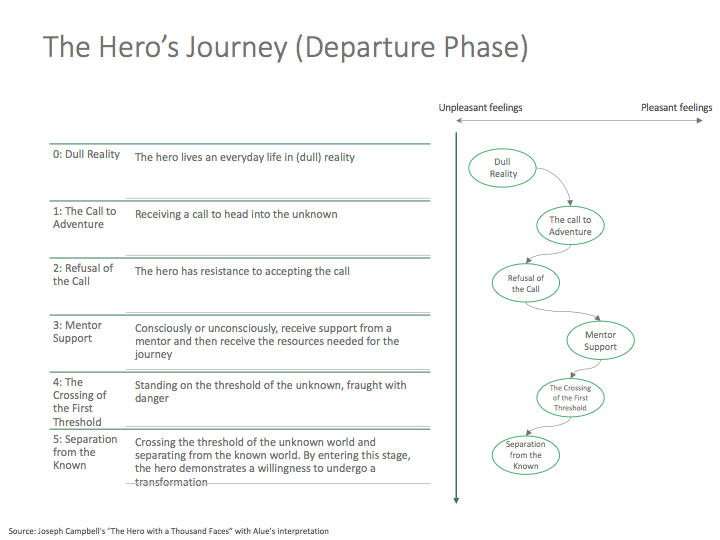
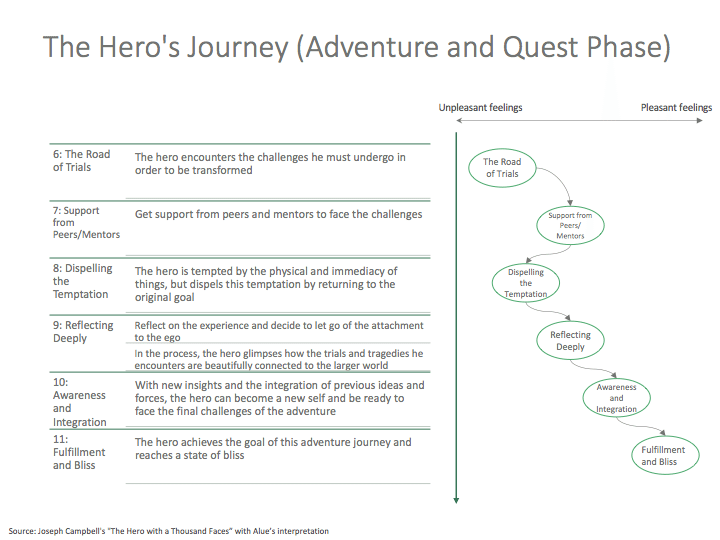
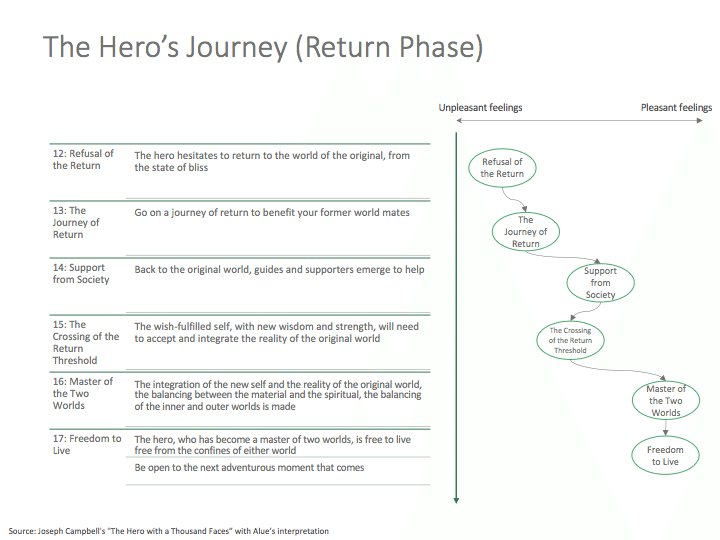
The Hero's Journey is said to be the archetype of not only a common storyline in mythology, but also a prototype for the stories of hit movies. For example, George Lucas used the Hero's Journey as a reference in part to come up with a Star Wars storyline.
The other, "The Ten Bulls," is an introduction to Zen in the Chinese era of Song Dynasty. It is a metaphor for the human mind, on which there is a bull, which is usually docile but can be very powerful when out of control. By describing the process of finding the bull, taming it, and becoming one with it, the book shows the way to spiritual enlightenment.

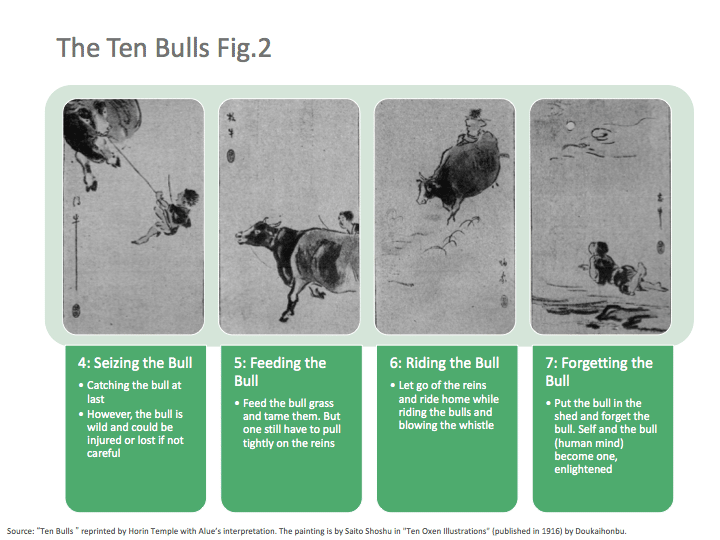
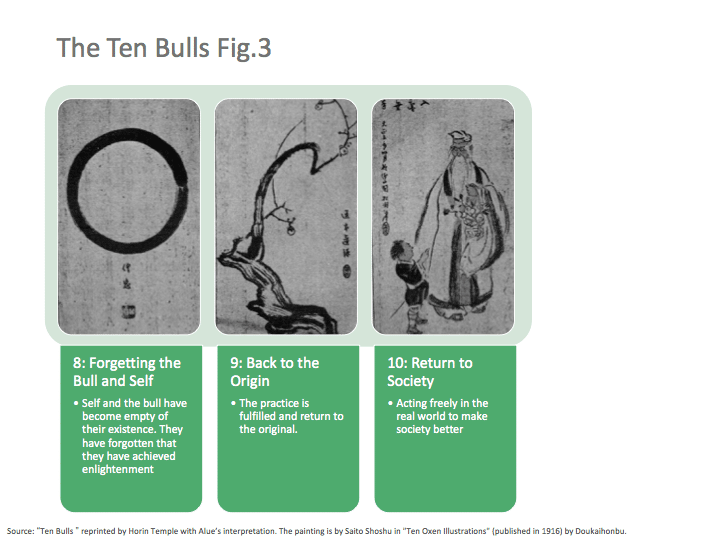
What they both have in common is that they depict (essentially) the inner struggle of a person and describe the process of overcoming that struggle.
In The Hero's Journey, the challenges may be facing with a different monster or a villain, but what it essentially describes is the inner life of the hero. The hero's inner conflict is depicted in the form of a confrontation between the hero and the villain.
In "The Ten Bulls," the inner conflict is also depicted as a process of searching for, finding, taming, and uniting a bull (i.e., one's mind).
The reason why I talk about stories of overcoming conflicts is because it is easier to face the inner conflicts of contradictions by imagining such a common story, or story archetype.
You can prepare your mind by thinking, "I am on a journey of XX theme, and the next phase will be XX." In this way, you can reduce the risk of panic, such as "Why on earth is this happening to me?"
I've talked before about how when you struggle with inner contradictions, it's good to be aware of two selves: self as the film actor struggling with the contradictions and another self as the film director observing the struggle.
By imagining "The Hero's Journey" or "The Ten Bulls," you, as the actor/hero of the story, can become more immersed in the story, and you, as the director of the story, can observe the outcome of the story from a bird's-eye view, more calmly.
As a result, the process of conflict as the actor/hero becomes a deeper, richer experience, and the process of observing the conflict as the director becomes calmer and more confident.
Another benefit of imagining these story archetypes is the timeline. In a previous article, I mentioned that the transformation of the stages of mental maturity described in the Constructive Developmental Theory can take years, sometimes more than a decade, to occur.
Although each person's perception is different, I believe that growth on a scale of a few years or ten years is too long to be aware of on a daily basis. This is not to say that the stages described in the Constructive Developmental Theory are meaningless. I think they are very useful as a map of the entirety of mental maturity, and I think they are very significant in knowing the current stage of one's consciousness.
However, as I mentioned earlier, I am aware of the challenge that the developmental stages of the Constructive Developmental Theory may be a bit too long a time frame to be aware of on a day-to-day level. On the contrary, I think the common story of "The Hero's Journey" and "The Ten Bulls" can be viewed as a time axis of months or a year, and it is easy to imagine that we are on a journey with a theme of "XX" and that the next phase of "XX" is waiting for us.
(As for the Ten Bulls, I think the process from the first "Searching for the Bull" to the seventh "Forgetting the Bull" can be viewed as a few months to a year, but the elements after the eighth that cannot be described in a time frame.)
In this article, we talked about how leaders need to experience inner contradictions and conflicts in order to mature mentally, and how being aware of the archetype of the story of the process of conflict can help them to overcome it.
In my next post, I'll talk about how we can create the experience of inner contradiction and conflict.
Here are the quests of the day. (If you'd like, please share your thoughts in the comments.)
・What inner conflict, if any, did you experience that allowed you to grow mentally?
・When you apply the process of overcoming inner conflicts to "The Hero's Journey" or "The Ten Bulls", what kind of scene comes to mind?
Bunshiro Ochiai
この記事が気に入ったらサポートをしてみませんか?
